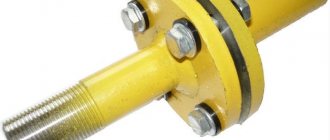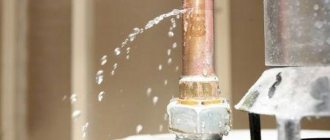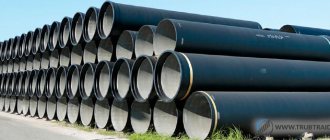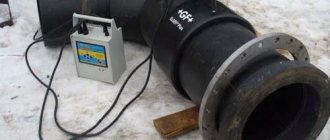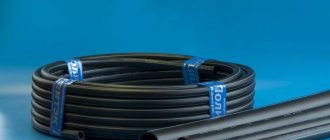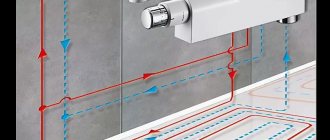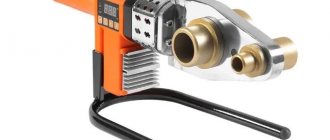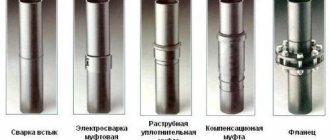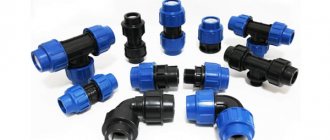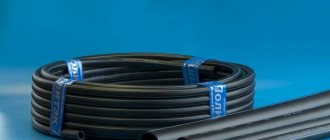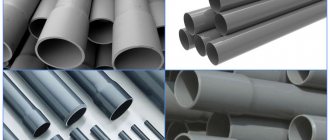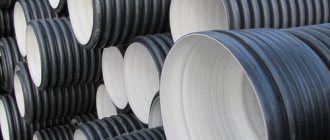Flange connection of polyethylene pipes. As you know, polyethylene pipes have two main types of connections, detachable and permanent. A permanent connection is made using a welding process in which the pipes are fused together, forming a reliable single connection. A permanent connection involves the installation of pipes using fittings, which are assembled mechanically and the unit assembled with their help can, if necessary, be disassembled.
Flange connection of polyethylene pipes is one of the detachable installation methods used for connection with shut-off and control valves. The flange connection is made using a flange sleeve welded to the end of the PE pipe and a free metal flange.
Bushing for flange Flange for bushing
Flange connection diagram
Flange connection of polyethylene pipes
1. Polyethylene pipe; 2. Bushing for flange; 3. Loose flange;
The selection of shut-off, control and other valves installed on polyethylene pipelines is carried out in accordance with standards, technical specifications, catalogs, parameters of transported substances, taking into account the requirements of the project and operating conditions.
Pressure polyethylene pipelines are connected to pipelines made of other materials using detachable steel flange connections.
The bushing for the flange at the base of the collar has a special structural expansion designed for more reliable connection of the collar. After all, it is on the bushing collar that the main pressure occurs during pipeline operation. Conventional flanges supplied for steel pipes in accordance with GOST 12820.80 cannot be freely installed on the sleeve due to the narrow internal diameter. Therefore, for flange connections of polyethylene pipes, free bored flanges are used in accordance with GOST 12822.80 with an increased internal diameter d1, which allows you to freely put it on a PE pipe.
Flange free
d - internal diameter of the flange according to GOST 12820.80; d1 - free bored flange according to GOST 12822.80.
Matching PE pipes and loose metal flanges
| Nominal outer diameter of PE pipe, mm | Diameter “Dy” of a free metal flange, mm |
| 50 | 40 |
| 63 | 50 |
| 75 | 65 |
| 90 | 80 |
| 110, 125 | 100 |
| 140 | 125 |
| 160, 180 | 150 |
| 200,225 | 200 |
| 250,280 | 250 |
| 315 | 300 |
| 355 | 350 |
| 400 | 400 |
| 450,500 | 500 |
| 560,630 | 600 |
| 710 | 700 |
| 800 | 800 |
| 900 | 900 |
| 1000 | 1000 |
| 1200 | 1200 |
Types of connections
Thus, to connect dissimilar pipes, use:
- NPSP is a permanent connection in gas, sewer and water mains, for which a special-purpose adapter is used. The connection is essentially a welding of a polyethylene pipe to a steel pipe.
- Compression couplings equipped with threaded threads - compression fitting. It is used in conjunction with ferrules and gaskets, which can be changed as they wear out.
- Flange transition.
What are flanges for connecting dissimilar pipes
Connecting pipes made of dissimilar materials using flanges is optimal when installing a pipeline in which it is necessary to connect a metal pipe with HDPE or shut-off devices. For this purpose, a sleeve is used together with a pressure flange, which in turn is secured with bolts. The collar (the second name of the part) prevents the flange from slipping when the pressure in the pipe increases.
There are two types of bushings:
- Segmental, i.e. HDPE elements connected by butt welding.
- Cast structures with no welds. The cast HDPE bushing provides the flange with the necessary support and prevents the unit from coming apart. It is also assumed that there is a second flange on the metal pipe.
The part is easy to install and does not require special maintenance. A variety of standard sizes allows you to select bushings of any size for any pipe diameter.
Flanges are also divided into two types:
- Fixing, when the flange is put on a metal pipe, and a HDPE pipe product is attached to the other end and the entire structure is secured using a clamping ring and seal.
- Threaded - the flange has a thread on one side onto which a HDPE pipe with a seal is screwed.
Note! When installing, it is important to pay attention to the smoothness of the steel parts: any burrs or protrusions can damage the polyethylene.
NPSP
The design is most often used when replacing phased sections of a metal system with polyethylene, as well as for installing shut-off valves.
For installation, thermistor welding is used, when the end of a polyethylene pipe is heated with a special tool and melted to a viscous mass, and then connected to a steel pipe under pressure. This connection is used for installation of high-pressure pipelines.
Regulatory documents regulate the technical characteristics of NPSP:
System pressure limits:
- for gas lines PE 80 - 6.4 bar, PE 100 -10 bar
- for water pressure systems PE 80 - 12.5 bar PE 100 - 16 bar
The length of the pipes is regulated by GOST TU4859-02603321549-98 - for gas, and TU2248-001-86324344-2009 - for water supply systems operating under pressure.
Compression coupling connection
This is a collapsible modular design, the parts of which are easy to replace.
The body is made of polypropylene, equipped with a pipe stop and a trapezoidal thread. A fixing sleeve with a sealing gasket that ensures tightness and prevents the pipe from deforming and shrinking. The crimp ring securely holds the pipe in a stationary position.
Mainly used for plumbing systems.
Couplings come in different shapes:
- transitional,
- connecting,
- square,
- plug,
- tee,
- branch
They can have both internal and external threads.
The diameter of the part varies from 16 to 110, and the working pressure value - from 10 to 16.
Methods for joining polyethylene pipes
- all cities
- Moscow (809)
- St. Petersburg (259)
- Abakan (2)
- Aginskoye (0)
- Adygeisk (0)
- Alexandrov (4)
- Almetyevsk (6)
- Anadyr (1)
- Anapa (8)
- Angarsk (4)
- Arzamas (3)
- Armavir (2)
- Arsenyev (1)
- Arkhangelsk (9)
- Astrakhan (1)
- Akhtubinsk (0)
- Akhty (0)
- Achinsk (0)
- Baykalsk (1)
- Balakovo (4)
- Barnaul (11)
- Bezhetsk (0)
- Belgorod (13)
- Belorechensk (2)
- Beloyarsky (0)
- Berezniki (5)
- Berezovo (0)
- Biysk (7)
- Birobidzhan (1)
- Blagoveshchensk (1)
- Bologoe (1)
- Bratsk (3)
- Bryansk (13)
- Budennovsk (1)
- Buynaksk (0)
- Velikiye Luki (3)
- Veliky Ustyug (1)
- Verkhniy Ufaley (0)
- Verkhoyansk (0)
- Vilyuisk (0)
- Vladivostok (5)
- Vladikavkaz (0)
- Vladimir (18)
- Volgograd (24)
- Volgodonsk (5)
- Volzhsky (3)
- Vologda (14)
- Volokolamsk (2)
- Vorkuta (0)
- Voronezh (20)
- Votkinsk (5)
- Vuktyl (0)
- Vyborg (0)
- Vyazniki (0)
- Vyazma (0)
- Gagarin (1)
- Gelendzhik (3)
- Glazov (1)
- Golitsyno (2)
- Gorno-Altaisk (2)
- Gorokhovets (1)
- Hot (0)
- Grozny (0)
- Gus-Khrustalny (1)
- Dalnerechensk (1)
- Derbent (0)
- Dzerzhinsk (6)
- Dmitrov (8)
- Dombay (0)
- Dubna (1)
- Dudinka (0)
- Yegoryevsk (3)
- Yeysk (2)
- Ekaterinburg (77)
- Yelets (1)
- Essentuki (1)
- Zabaikalsk (0)
- Zlatoust (0)
- Ivanovo (13)
- Igirim (0)
- Izhevsk (15)
- Inta (1)
- Irkutsk (16)
- Istra (1)
- Ishim (0)
- Yoshkar-Ola (7)
- Kavalerovo (1)
- Kazan (30)
- Kaliningrad (8)
- Kaluga (17)
- Kamensk-Uralsky (3)
- Kamensk-Shakhtinsky (3)
- Kamyshin (1)
- Kanash (1)
- Kandalaksha (0)
- Kansk (2)
- Karachaevsk (0)
- Kashira (2)
- Kemerovo (5)
- Kizlyar (0)
- Kimry (4)
- Kingisepp (4)
- Kirov (15)
- Kiselevsk (0)
- Kislovodsk (3)
- Klimovsk (2)
- Wedge (5)
- Kovrov (3)
- Kogalym (1)
- Kolomna (7)
- Komsomolsk-on-Amur (1)
- Korenovsk (0)
- Kostomuksha (0)
- Kostroma (7)
- Kotlas (1)
- Red (0)
- Krasnogvardeysk (0)
- Krasnodar (62)
- Krasnoyarsk (19)
- Kropotkin (3)
- Krymsk (3)
- Kudymkar (0)
- Kumertau (1)
- Kurgan (4)
- Kursk (10)
- Kushchevskaya (1)
- Kyzyl (1)
- Labinsk (0)
- Lagan (0)
- Lipetsk (12)
- Long Yugang (0)
- Lytkarino (3)
- Lyubertsy (11)
- Magadan (0)
- Magnitogorsk (4)
- Maykop (3)
- Maloyaroslavets (3)
- Makhachkala (5)
- Mezhdurechensk (0)
- Miass (4)
- Millerovo (0)
- Minvody (1)
- Mirny (0)
- Mikhailov (0)
- Mikhailovka (0)
- Michurinsk (0)
- Mozhaisk (2)
- Mozdok (0)
- Muravlevo (0)
- Murmansk (0)
- Murom (4)
- Naberezhnye Chelny (16)
- Nadym (0)
- Nazran (1)
- Nalchik (3)
- Naro-Fominsk (3)
- Naryan-Mar (0)
- Nakhodka (1)
- Nevinnomyssk (3)
- Neftekamsk (1)
- Neftekumsk (0)
- Nefteyugansk (1)
- Nizhnevartovsk (4)
- Nizhnekamsk (9)
- Nizhny Novgorod (53)
- Nizhny Tagil (3)
- Novgorod the Great (8)
- Novozapolyarny (0)
- Novokuznetsk (4)
- Novorossiysk (5)
- Novosibirsk (35)
- Novotroitsk (0)
- Novouralsk (1)
- Novocherkassk (4)
- New (0)
- Noginsk (9)
- Norilsk (1)
- Noyabrsk (0)
- Nyagan (3)
- Odintsovo (11)
- Oktyabrskoye (0)
- Omsk (4)
- Eagle (19)
- Orenburg (8)
- Orekhovo-Zuevo (3)
- Orsk (1)
- Pavlovsky Posad (5)
- Partizansk (1)
- Penza (8)
- Pervouralsk (3)
- Peregrebnoye (1)
- Pereslavl-Zalessky (3)
- Perm (9)
- Petrozavodsk (5)
- Petropavlovsk-Kamchatsky (3)
- Cockerels (1)
- Pechora (0)
- Podolsk (10)
- Primorsko-Akhtarsk (0)
- Subpolar (0)
- Cool (1)
- Pskov (7)
- Pyatigorsk (5)
- Rainbow (1)
- Reutovo (1)
- Riga (0)
- Rzhev (2)
- Rostov (6)
- Rostov-on-Don (43)
- Rubtsovsk (1)
- Rybinsk (1)
- Ryazan (7)
- Salekhard (0)
- Salsk (1)
- Samara (20)
- Saransk (3)
- Sarapul (2)
- Saratov (13)
- Sayansk (0)
- Svetlograd (0)
- Light (0)
- Severodvinsk (2)
- Sergiev Posad (4)
- Serov (2)
- Serpukhov (9)
- Slavyansk-on-Kuban (7)
- Smolensk (12)
- Soviet (3)
- Sosva (0)
- Sochi (14)
- Spassk-Dalniy (0)
- Stavropol (15)
- Stary Oskol (10)
- Sterlitamak (3)
- Strezhevoy (2)
- Surgut (5)
- Syzran (2)
- Syktyvkar (2)
- Taganrog (2)
- Tambov (7)
- Tashtagol (2)
- Tver (13)
- Timashevsk (4)
- Tikhoretsk (4)
- Tobolsk (1)
- Togliatti (9)
- Tomsk (4)
- Torzhok (4)
- Tosno (2)
- Troitsk (0)
- Tuapse (1)
- Tula (20)
- Tura (0)
- Tynda (0)
- Tyumen (10)
- Uvarovka (1)
- Uglich (0)
- Uzyum-Yugan (0)
- Ulan-Ude (2)
- Ulyanovsk (11)
- Urus-Martan (0)
- Uryupinsk (0)
- Usolye-Sibirskoye (2)
- Ust-Ilimsk (1)
- Ust-Kut (0)
- Ust-Labinsk (0)
- Ust-Ordynsky (1)
- Ufa (26)
- Ukhta (1)
- Fryazevo (1)
- Fryazino (0)
- Khabarovsk (8)
- Khanty-Mansiysk (1)
- Kharkov (2)
- Khasavyurt (0)
- Hilimsunt (0)
- Virgin land (0)
- Tsimlyansk (0)
- Cheboksary (10)
- Chelyabinsk (25)
- Cherepovets (9)
- Cherkessk (0)
- Chersky (0)
- Cherusti (1)
- Chita (1)
- Miracle (2)
- Mines (4)
- Elista (1)
- Elektrostal (5)
- Yugorsk (4)
- Yuzhno-Sakhalinsk (0)
- Yurga (2)
- Yakutsk (0)
- Yamburg (0)
- Yaroslavl (19)
During major or current repairs, the question often arises - how to connect a plastic pipe with a metal one, which is associated with the need to replace worn out sections of communications of varying lengths. A similar problem may arise during the construction of a private household - when connecting to centralized engineering systems. Correct joining of pipes made of different materials is not inferior in reliability to joints of identical pipes, so it is important to find out in advance how to connect dissimilar sections.
Cases of connecting dissimilar pipes
Some cases where it is necessary to connect plastic pipes with metal ones are described above. In most cases, systems installed a certain time ago turn out to be metal. Currently, plastic is chosen not only because of its reasonable price and good technical characteristics, but also because of the large selection of standard sizes of pipes and fittings, which make it easy to find components of any configuration for replacement.
An example of connecting a plastic pipe to an iron pipe
Sometimes pipes made of different materials (metal and plastic) are used when installing a system from scratch. For example, when laying an external section of water supply or sewerage for a private house, sometimes it is necessary to lay pipelines under a car entrance or parking lot. The dynamic load on the ground surface during vehicle movement will be transferred to communications located in the ground. It is recommended to install metal pipes in these areas, however, using metal to install the entire system is not economically feasible and less practical.
Methods for connecting metal pipes to plastic ones
There are two ways to connect plastic pipes with metal ones, which are used for steel pipelines.
- Threaded connections are used in cases where the diameter of the pipes being connected does not exceed 40 mm.
- Flange connections are optimal for large diameters, since tightening the threads in such cases can be difficult.
Features of threaded connections
In order to understand how to connect a plastic pipe to a metal pipe using threads, you should study the fittings used for these purposes. They are adapters, on one side of which there is a thread for connecting a metal pipeline and a smooth coupling for soldering plastic pipes on the other. There are also models for connecting a larger number of dissimilar lines, as well as fittings for making turns and bends.
Polypropylene fittings with threads for transition from polypropylene to metal
The threaded connection of steel and plastic (polypropylene) pipes is performed in a certain sequence.
- The connection point is prepared from the side of the existing metal communications. If there was already a threaded connection in this place, it unscrews. If the pipes have been welded or the place where the plastic insert is installed is the middle of a whole steel pipe, the latter is cut, after which lubricant is applied to the edge and the thread is made using a thread cutter.
- The end of the threaded steel pipe is cleaned and a sealing material is applied to it: tow or fum tape with silicone grease. In order to eliminate the possibility of leaks, it is important to perform sealing correctly - lay no more than 1-2 turns of winding in the direction along the thread.
- The threaded edge of the fitting connects to the metal thread. In this case, not only should you not use special tools, but also not over-tighten the connection by hand. Significant force may cause the fittings to crack. It will not be difficult to tighten the threads additionally if after installation, during a test filling of the system, leakage is detected.
- After completing work with the threaded part of the connection, the plastic pipe is fixed to the smooth coupling of the fitting by welding.
The fitting for polyethylene pipes (HDPE) at one end has a thread for connection with metal, and at the other there is a compression clamp for the HDPE pipe - unlike polypropylene pipes, no welding is required here
Making flange connections
The connection of a plastic pipe to a metal pipe without threads is made using flanges. Its advantage is the ease of dismantling for repairs or cleaning of communications.
Connecting elements for detachable connections of dissimilar pipelines are flanges of various types.
- Light structures with a diameter not exceeding 300 mm, as well as medium and heavy pipes up to 150 mm, are connected using loose flanges, with a straight collar for support. Such modifications are most common when installing communications in private households and high-rise apartments.
- For pipes of any type with a diameter of up to 200 mm, loose flanges with a tapered collar can be used.
- A shaped flange and a steel projection using a wedge type connection is a universal option.
- Maximum strength can be achieved using a straight collar with a tapered transition.
Flange connection for HDPE pipes
As preparatory work before installing the flange connection, it is important to carefully inspect the prepared flanges. There should be no burrs on them, which during installation could cause damage to the plastic part of the connection. In most cases, such burrs are quite easy to remove.
The procedure for assembling a unit with a flange connection is as follows:
Installation of a plastic pipe to a metal pipe using flanges
- The steel pipe is cut at the intended insertion site. It is important to make the cutting line evenly and accurately.
- The flange is placed on the pipe.
- To ensure the tightness of the connection, a rubber gasket is installed, the size of which should be such that it does not extend beyond the cut line by more than 10 mm.
- The main elements of the assembly are connected - the flange placed on the pipe is combined with the gasket and fastened to the second flange using bolts.
Tightening should be done by evenly turning the fastener threads around the entire circumference and avoiding unnecessary force.
If you are wondering what is the best material to make a country water supply from, we recommend that you read our article “Plastic pipes for water supply in the country.” Types and installation tips.
The easiest way to install HDPE pipes is to use fittings. We have another article about compression fittings for polyethylene pipes.
If you need to choose press jaws for installing metal-plastic pipes, then here you will find useful information.
Features of connecting sewer pipes
When installing a sewer system, a connection between a cast iron pipe and a plastic pipe is often required, which is structurally different from the joints between steel and plastic pipes. For such connections, special components are required:
- cuffs,
- corrugations,
- seals.
Transition sleeve cast iron-plastic
In most cases, selecting and purchasing components is not difficult. At the same time, and in those rare cases when it is not possible to find a suitable seal, the problem can be solved using available materials. The seal of the required size can be cut from microporous rubber, for example, from an old car mat. A long narrow tape is placed in the gap between the elements being connected and sealed using a blunt wide screwdriver. The sealing is done without excessive force so as not to damage the plastic. If a leak is detected during a test filling of the system, the connection can be further sealed.
Sealing the joint using caulking or cement mortar is not acceptable.
- When embossing, the ductile plastic pipe is deformed, the joint will not be tight, and there is a high probability of leakage.
- Cement mortar will not last long. Due to the large difference between the coefficients of thermal expansion of materials, the seam will become looser each time hot water is drained. In the near future, the cemented joint between the plastic and cast iron sections of the pipeline will crack and cease to be airtight.
Connecting plastic pipes with copper pipes is extremely rare, but special fittings for such connections can also be found on sale. They have two smooth couplings - one for soldering a copper pipeline, the other for connecting to a plastic pipe.
Advantages of using HDPE pipes
It is easy to assemble a water supply from HDPE pipes
Today, pipes made from low-pressure polyethylene are in great demand. This is facilitated by the positive qualities of such products. Namely:
- Long service life (more than 50 years).
- Immunity to aggressive environments.
- Corrosion is not a problem for such pipes.
- It is possible to carry out installation using a trenchless method, which significantly reduces the cost of all work, but limits the period of use of such a water supply system.
- The inside of the pipe is very smooth. This prevents deposits and build-ups from forming, which eliminates the possibility of blockages.
- The pipes are very light, this greatly facilitates and speeds up the laying of pipelines;
- HDPE products are not afraid of temperature changes.
- Pipes have great ductility. The constructed pipeline easily tolerates soil movements. That is why such pipes are often used in earthquake-prone regions.
But there are also some disadvantages. Thus, HDPE pipes do not tolerate ultraviolet radiation well. Also, such pipelines are not designed for pumping liquids with high temperatures, as a result of which they can be deformed.
What are HDPE pipes?
Polyethylene is a widespread and well-known plastic. But pipes from it began to be made not too long ago - about 50 years ago. The name "low-density polyethylene" comes from the method of production of polyethylene and has nothing to do with the quality of the plastic.
Pipes can be black, bright blue, black with blue and yellow stripes, gray (for sewerage), and rarely other colors. Blue or black with blue stripes products are intended for drinking water supply, black products are for technical purposes. Diameters – from 16 to 1600 mm. Manufactured as measured products 12 m long or in coils (if the diameter does not exceed 160 mm)
Butt welding
Butt welded HDPE pipe
Special equipment is used for butt welding of polyethylene pipes. At the same time, it is very difficult to do such work on your own; for this you need to have special qualifications. Butt welding of HDPE pipes is carried out in two ways:
- using a mechanical welding machine;
- using an electrohydraulic welding unit.
The first method is used only when installing pipelines with low pressure. These include sewerage and wastewater disposal systems at industrial enterprises. Electrohydraulic equipment is capable of creating pipelines for any purpose. Connections made using this method are strong and durable. The pipelines themselves can withstand high pressure and any mechanical stress.
Welding a rotary bend
Various HDPE parts can also be used for welding pipes. Thus, the industry produces bends, crosses, tees, transitions, etc. With their help, you can create a pipeline system of any configuration.
But, as mentioned above, welding requires the use of special equipment and sufficient experience. For these reasons, this method is rarely used in everyday life. A simpler, but no less reliable way to connect HDPE pipes (and not only to each other) is to use fittings.
Using fittings
HDPE pipes can be connected using special fittings. Such designs are used when creating communications from small-diameter pipes (up to 50 mm). The following types of fittings can be used:
- electric welded;
- compression;
- reduction.
Electric welded coupling connection
The first option is a coupling with an electric heating element inside. When connected (after connecting to electricity), the fitting heats up and melts the polyethylene. The result is a strong and reliable connection, but at the same time non-separable.
To carry out the work, you must first clean the pipe and fitting from dirt. Then they are aligned along one axis, thereby achieving immobility of the entire structure. After this, the connecting element is connected to a current source specially designed for this purpose. As a result of heating, the plastic begins to melt, tightly connecting all elements. You can learn more about working with such connecting elements by watching a video from the Internet.
Fitting
The easiest way to connect HDPE pipes is to use a compression fitting. Anyone can cope with this task, even without any skills. Such fittings consist of:
- polyethylene body;
- O-rings;
- clamping rings (they protect the connection from mechanical damage);
- bushings;
- cover nuts.
Before starting work, you need to disassemble the design of the connecting element. Then at the end of the pipe we mark the distance at which it should go into the fitting. Next, after wetting it in water, we put on the connecting element. The last step is to tighten the cover nut (no need to use excessive force). The result is a connection without the risk of leakage, and it is also collapsible.
In addition, compression fittings have another advantage - the ability to connect pipes of different materials (by material). Very often, when renovating an apartment, it is necessary to connect communications to old metal pipes. Using compression fittings, making such a connection is very easy. The work process is the same as in the case of joining two polyethylene pipes.
Reducing fitting
Reducing fittings are used when it is necessary to connect two pipes of different diameters. The principle of using this connecting element is the same as that of the compression one.
How to connect plastic and metal?
In recent years, polyethylene (PE) pipes have been actively displacing traditional cast iron and steel products from the construction market. Plastic structures are superior to metal ones in a number of respects. Therefore, this process has a completely logical explanation - everyone wants to have in their home reliable and inexpensive water supply, heating, and sewage systems, assembled without welding. When installing plastic pipes you have to face one problem. It lies in the fact that many elements of household pipelines in apartments are made of metal products.
READ ALSO: How to Make a Staircase from PVC Pipes
Connection of plastic and metal pipes
And here it is important to correctly connect PE pipes with steel (cast iron) pipes. This can be done in two ways: using flanges and fittings. A flange connection of polyethylene (polypropylene) pipes with steel pipes is recommended for cases where systems of products with a cross-section of more than 50 mm are installed. But pipelines with a diameter of up to 50 mm are better connected with fittings. They are special elements that have a smooth coupling for connecting PE pipes and threads for metal pipes.
Connecting polypropylene pipes to each other
Diffusion welding
Now the question of how to connect polypropylene pipes is a popular one. The most common method is diffusion welding. In order to securely fasten them, fittings are used: couplings, angles, adapters.
When installing a cold water supply system, polypropylene pipes will definitely last up to fifty years. They will last approximately twenty-five years when installing hot water pipes. Please note that operating time depends on inlet pressure and temperature.
Polypropylene products are very durable and can cope with any changes in the system. High pressure and low temperature conditions can in no way affect the duration of their operation. High pressure and temperature, which are recorded at the same time, will reduce the service life of pipes by five to seven years. There are no extreme loads in home pipelines that can deform them, so there is no need to worry.
Device "Fusiotherm"
If you are interested in connecting with each other, pay your attention to this device. Cold polypropylene products are joined, then the joint is processed using the Fusiotherm device. If you need to weld 2 ends of pipes, they are inserted into a special hole in the device, after preheating the device to two hundred and sixty degrees. Then they are pulled out and connected.
Socket soldering
If the radius is less than twenty millimeters, then they can be connected by manual welding. To connect to a metal part, you must use a different method. You will need a special soldering iron for socket soldering.
1. Cut a piece of the product with special scissors. If there is reinforcement, process it and clean the reinforcement layer in the cut area.
2. Put on gloves, heat up your soldering iron and start soldering.
3. Do everything quickly so that the joint area does not become deformed.
Connection of polypropylene pipes with metal ones
The question remains relevant: how to connect polypropylene pipes (under high pressure conditions) with metal ones? There are 2 methods. You need to choose one of them based on the radius.
1. For products with a radius of up to 20 mm, you need to use threaded connections on the metal part of the system. Fittings, on one side of which there is an ordinary coupling for mounting to plastic, and on the other - the required thread, are sold everywhere. In order to seal steel threads, use flax with drying oil or modern sealing materials. This will ensure the durability of the connection.
2. For larger sizes it is better to use flange connections. An iron thread with a radius of 300 mm cannot be screwed in by hand, even if you are a strong man. So how then can you combine a metal pipe and a polypropylene pipe if they are large in diameter? Use special adapters that can be purchased at the store.
Threads and flanges allow you to connect metal and polypropylene pipes without soldering, which is very convenient.
Flange connections - we assemble the pipeline quickly and efficiently
The flange is made in the form of a threaded part. It is most often used to connect metal and polyethylene water pipes, as well as gas communications without welding. Flanges for assembling household networks from different materials have not only threads on one side, but also a mandatory seal. The latter is located at the second end of the described element. The seal guarantees a tight and truly strong connection, which can always be disassembled if necessary.
Flange connection example
To lay communications you can use:
- metal flanges;
- flanges for special bushings (they are called collars).
The right choice of polypropylene products
It is difficult to choose something specific from the wide range provided by many manufacturers. There are criteria that must be followed when purchasing.
1. Products must be in accordance with the specifications of the plumbing/heating system.
2. In order to assemble the system with high quality, you need to purchase all parts from one manufacturer. This approach will allow you to create a reliable and durable structure.
3. When choosing, pay attention to the quality of pipelines and fittings. Evaluate the following:
- smoothness of internal/external surface;
- the presence of cracks, chips, bubbles, heterogeneous structure, foreign particles;
- correct geometry;
- same wall thickness.
4. Remember that polypropylene products are intended for use at temperatures not less than minus twenty. Ask the store how to store them in winter. Improper storage leads to product deformation.
5. If drinking water will be supplied through the water supply system, ask the seller whether the product meets the standards of sanitation and hygiene.
6. Buy only straight pipes, without bends. In stores they are stored vertically, so they gradually bend and are no longer straight. Be sure to pay attention to this.
7. Choose products from trusted manufacturers that have proven themselves and have all the necessary certificates. Trying to save money, you can buy a low-quality product that will not last you the entire operational period. Therefore, it is better to pay more once than to spend money again and carry out complex repairs to the plumbing/heating system.
What are clamping flanges
First, let’s find out: what are clamping flanges? They are classified as specialized fittings for pipelines. And they are flat bored parts.
At first they are made according to a certain standard, then they are bored to obtain different diameters.
These connecting elements are used to connect tanks and metal pipelines with HDPE pipes through a sleeve. Thanks to such parts, the tightness, reliability, and strength of the unit are ensured. Polyethylene pipes are welded directly to the sleeve.
Characteristics and Features
The flange, in accordance with GOST, is produced by boring to the required diameter. The following steel grades are used:
- Art. 20;
- Art. 3.
The flanges are used in conditions where the temperature of the working medium corresponds to the range from -70 to +300 °C.
A retaining fitting is a flat product similar to a disk. It is designed for bolts, has holes, they are equidistant from each other. The part is installed together with the bushing, which is expanded for reinforcement.
In this regard, it turns out that the part itself does not fit well into the flange. However, this problem is eliminated after using bored elements. The internal diameter of the latter is increased to the required values, therefore perfect sealing of the joint is possible. Other parametric standards of the element are similar to analogues of the standard sample made of steel. Fundamental parameters characterizing flanged products for polyethylene pipelines:
- external dimension;
- diameter inside;
- operating pressure.
It is also important what the weight is.
Advantages of parts
The flange adapter of the clamping sample has a number of advantages in comparison with other elements. Therefore, it is quite common with specialized use. But for work you always need a flange connection diagram.
Experts call the following indicators the main advantages of the fitting:
- To install it, there is no need to spend a lot of time or use specially selected tools. So, you will need a wrench and a minimum of skills. With such “baggage” it is quite possible to install the part without any obstacles;
- The flange clamping adapter is capable of compensating for axial compression/tension, which makes the installation itself, as well as further operation, easier, and less time is spent on installation work.
Also, with such an adapter, reinforcing elements can be installed in a pipeline made of metal. And the repair activities of such systems become significantly simplified.
Connection methods
Pipes made of low-density polyethylene can be connected in detachable and permanent ways. Below we will talk about each of these methods.
Detachable connections
This type of connection is used on diameters up to 315 mm inclusive, but it is advisable to use on diameters no more than 110 mm. It is as reliable as one-piece methods.
Its advantages:
- speed and ease of installation;
- economical - no special equipment required; couplings and other fittings are not too expensive;
- accessibility - can be used in cramped conditions, under water, for example.
Connectors (fittings, couplings) are mounted in the following order:
- the ends are carefully cut perpendicular to the length of the pipe; cleared of burrs;
- the ends are chamfered (using a special device or a sharp knife);
- a connecting element is placed on the ends (it fits into the adapter quite tightly);
- then carefully tighten the nut on the fitting.
Connection with couplings
This is the fastest way to assemble pipelines and does not require special equipment. Can easily be used at home.
Polyethylene couplings come in several types:
- connecting – connect pipes of the same diameter;
- reduction – used as a transition for different diameters;
- compression – designed for connecting PE pipes with various shut-off equipment, steel, propylene or PVC pipes.
Couplings can be straight or angular. Types of couplings are shown in the table.
Fitting connection
Compression fittings are a type of connecting parts for water pipes.
Installing them is similar to installing couplings.
Flange connection
It is used on large-diameter main pipelines (at least 40 mm) for installing gate valves, valves, regulators (for their subsequent removal for repair or replacement).
To secure the flanges, special couplings are welded to the ends of the pipeline, then the flanges are screwed onto them.
Permanent connections
The only possible method for connecting large diameters.
Butt welding
It is advisable to use this type of welding to connect workpieces with a wall thickness of at least 5 mm.
The ends are cleaned, chamfered, inserted into a special heater, melted, then the workpieces are joined, pressed and held motionless until completely cooled.
Electrofusion welding
The two pipes being connected are inserted into a special coupling, inside of which there is a heating element. Then voltage is applied to it from a special apparatus, the coupling and workpieces are heated and welded. A very convenient welding method. And very expensive. For large diameters, the cost of the coupling will be much higher than the cost of the pipeline on your site.
When performing this type of welding, special attention should be paid to pre-cleaning the ends and keeping the joint stationary until it cools completely.
Permanent joining of HDPE pipes
Permanent connections are usually used during the construction of pressure pipelines and when it is necessary to lay a solid pipeline without a detachable fitting. There are two types of connecting HDPE pipes using welding.
Welding with electric couplings
Connecting two pipeline elements of equal diameter using electrofusion welding is considered the simplest method of permanent joining.
To perform the work you need a special fitting - a coupling. A heating element - a spiral - is mounted inside this part. After applying voltage, the heater melts the inner wall of the coupling and the surface of the HDPE pipe. The result is reliable welding of two workpieces of the same diameter to each other. The soldering process consists of the following steps:
- two ends of pipes of the same diameter are cleaned of dirt and degreased;
- the workpieces are inserted into a coupling of the appropriate diameter, after which the unit being connected is secured.
There are two terminals on the coupling. Wires from the power source are connected to them. After applying current, the plastic melts, resulting in a strong connection. You can use the welded workpiece after the joint has completely cooled.
Docking by contact welding
The second method of permanent connection is based on the use of special equipment - a soldering iron.
Contact welding is used to connect elements of a plastic pipeline with a diameter of 50 mm or more. The advantage of this method is that it is cheap. If you need to make a lot of joints when installing a highway, it is more profitable to buy a soldering iron. This tool is affordable and may be useful in the future for welding various pipes and flexible hoses. The connection is made by contact welding according to the following principle:
- two workpieces of the same diameter are fixed in the clamps of the machine;
- after centering the pipes, begin heating their ends until the plastic begins to melt;
- the soldering iron is removed, and the ends of the molten workpieces are tightly connected using a clamping machine.
After cooling, a monolithic seam is obtained, which is not inferior in strength to the wall of a plastic pipe.
Expert advice
You cannot connect pipes with a noticeably pronounced ellipse - the quality of the seam will be unsatisfactory.
After welding, the welded unit must remain stationary until it cools completely.
Do not neglect cleaning the ends from soil, dust, sand, shavings and degreasing - these little things significantly affect the quality of the seam.
How to connect a HDPE pipe to a polypropylene pipe
Polyethylene and polypropylene cannot be welded. Correctly connect them together only using fittings. On the ends to be connected, you should weld or put on MCVs (couplings with internal threads) made of the appropriate material, screw a quick-disconnect threaded connection (“American”) onto one MCV, then connect two MCVs using a union nut.
How to join polyethylene and steel pipes
This joining is carried out similarly to the joining of HDPE and polypropylene. A steel pipeline usually ends with a thread. You can use the drive instead of the American one - but this option has already become obsolete.
On large highways, a valve or gate valve is usually mounted at such joints - in this case, a flange connection can be used.
We hope that our article helped the reader understand the intricacies of connecting low-density polyethylene pipes with their own hands. Share useful information with friends and acquaintances on social networks, invite friends and subscribe to our newsletter - and you will always be fully armed to begin any home repairs.
Advantages
- low cost;
- chemical inertness - does not react with alkalis or acids; the water does not acquire any foreign taste or smell;
- corrosion resistance; resistance to aggressive environments;
- durability - the first pipes have been in service for more than fifty years;
- smooth inner surface - such pipes do not “overgrow” with calcium salts, like metal ones;
- tolerate freezing with water inside and do not burst like metal ones;
- are not afraid of temperature changes (ranging from - 20 ° C to 40 ° C):
- plastic polyethylene easily tolerates soil movements;
- Manufacturability – easy and quick installation;
- polyethylene is environmentally friendly - its production and disposal do not lead to environmental pollution;
- their low weight facilitates their installation, storage, and transportation.
